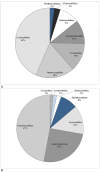Stomach contents of long-finned pilot whales, Globicephala melas mass-stranded in Tasmania
- PMID: 30640963
- PMCID: PMC6331100
- DOI: 10.1371/journal.pone.0206747
Stomach contents of long-finned pilot whales, Globicephala melas mass-stranded in Tasmania
Abstract
New data are reported from analyses of stomach contents from 114 long-finned pilot whales mass-stranded at four locations around Tasmania, Australia from 1992-2006. Identifiable prey remains were recovered from 84 (74%) individuals, with 30 (26%) individuals (17 females and 13 males) having empty stomachs. Prey remains comprised 966 identifiable lower beaks and 1244 upper beaks, belonging to 17 families (26 species) of cephalopods. Ommastrephidae spp. were the most important cephalopod prey accounting for 16.9% by number and 45.6% by reconstructed mass. Lycoteuthis lorigera was the next most important, followed by Ancistrocheirus lesueurii. Multivariate statistics identified significant differences in diet among the four stranding locations. Long-finned pilot whales foraging off Southern Australia appear to be targeting a diverse assemblage of prey (≥10 species dominated by cephalopods). This is compared to other similar studies from New Zealand and some locations in the Northern Hemisphere, where the diet has been reported to be primarily restricted to ≤3 species dominated by cephalopods. This study emphasises the importance of cephalopods as primary prey for Southern long-finned pilot whales and other marine vertebrates, and has increased our understanding of long-finned pilot whale diet in Southern Ocean waters.
Conflict of interest statement
The authors have declared that no competing interests exist.
Figures





References
-
- Cherel Y, Xavier JC, De Grissac S, Trouvé C, Weimerskirch H. Feeding ecology, isotopic niche, and ingestion of fishery-related items of the wandering albatross Diomedea exulans at Kerguelen and Crozet Islands. Marine Ecology Progress Series. 2017;565:197–215.
-
- Beatson E. The diet of pygmy sperm whales, Kogia breviceps, stranded in New Zealand: implications for conservation. Reviews in Fish Biology and Fisheries 2007;17:295–303.
-
- Beatson E, O’Shea S. Stomach contents of long‐finned pilot whales, Globicephala melas, mass‐stranded on Farewell Spit, Golden Bay in 2005 and 2008. New Zealand Journal of Zoology. 2009;36(1):47–58.
-
- Gales R, Pemberton D, Clarke M, Lu CC. Stomach contents of long-finned pilot whales (Globicephala melas) and bottlenose dolphins (Tursiops truncatus) in Tasmania. Marine Mammal Science. 1992;8(4):405–13.
-
- Evans K, Hindell MA. The diet of sperm whales (Physeter macrocephalus) in southern Australian waters. ICES Journal of Marine Science: Journal du Conseil. 2004;61(8):1313–29.
Publication types
MeSH terms
LinkOut - more resources
Full Text Sources
Miscellaneous

